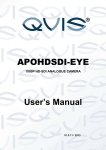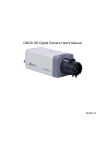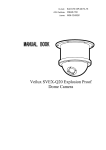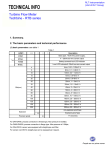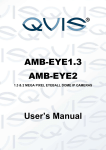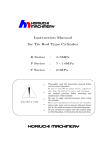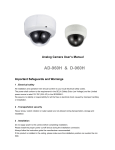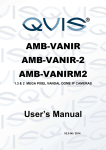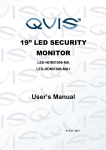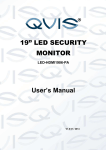Download APOHDSDI-VAN Manual
Transcript
APOHDSDI-VAN 1080P HD-SDI ANALOGUE CAMERA User’s Manual V1.0 11 / 2013 i Welcome Thank you for purchasing our 1080P HD-SDI ANALOGUE CAMERA. This user’s manual is designed to be a reference tool for the installation and operation of your system. Here you can find information about the corresponding analogue camera’s features and functions, as well as a detailed installation method. Before installation and operation please read the following safeguards and warnings carefully! ii Important Safeguards and Warnings 1.Electrical safety All installation and operation here should conform to your local electrical safety codes. The power supply shall conform to the requirement in the SELV (Safety Extra Low Voltage) and must make sure that the limited power source is rated 12V DC. Please note: Do not connect two power supplying sources to the device at the same time; it may result in device damage! We assume no liability or responsibility for all the fires or electrical shock caused by improper handling or installation. We are not liable for any problems caused by unauthorized modification or attempted repair. 2.Transportation Security Please ensure that the product does not endure heavy stresses, violent vibration or contact with water during transportation, storage and installation. Please use the original packing material (or the material of the same quality) if you need to return it to vendor. 3.Installation Do not apply power to the product before completing installation. Do not put object(s) on the product. Please install a proper power cut-off device during the installation connection. 4.Qualified engineers needed All the examination and repair work should be done by the qualified service engineers. We are not liable for any problems caused by unauthorised modifications or attempted repair. 5. Environment This product should be installed in a cool, dry place away from direct sunlight, inflammable, explosive substances and etc. Please keep it away from environments that contain electromagnetic radiation or objects that produce it. Please keep sound ventilation around the device at all times. Do not allow the water and other liquid to penetrate into the device if casing has been compromised. This series product complies with the IP66 standard specified in the Degrees of Protection Provided by Enclosure. Ensure lightning surge protection is in place to make sure you fully protect camera circuitry from electrical overload. iii Please make sure the CCD (CMOS) component is away from the radiation of the laser beam device. Otherwise it may result in CCD (CMOS) optical component damage. It is recommended that the grounding studs of the product should be grounded, so to further enhance the reliability of the camera. 6. Daily Maintenance Please shut down the device and then unplug the power cable before you begin any maintenance work. Do not touch the CCD (CMOS) optic component. Please use an air jet to clean the dust off the lens surface. You can use the dry cloth with some alcohol or mild detergent to clear if necessary. When the camera is not in use please put the dustproof cap to protect the CCD (CMOS) component. Do not use volatile solvent such as the benzene, paint thinner or detergent with the ability to abrade surfaces. It may result in lens damage or adversely affect the device’s performance. 7. Accessories Always use all the accessories recommended by manufacturer. Before installation, please open the package and check that all the components are included. Contact your local retailer/vendor ASAP if something is missing. 8. Box Contents: Accessory Name Amount Camera Unit 1 User’s Manual 1 Installation Accessories Bag 1 CD 1 iv Table of Contents 1 General Introduction ...................................................................................................... 1 1.1 Overview ........................................................................................................... 1 1.2 Features ............................................................................................................ 1 1.3 Specifications .................................................................................................... 2 1.3.1 Performance ............................................................................................... 2 2 Framework..................................................................................................................... 3 3 Installation ..................................................................................................................... 4 3.1 Device Installation ............................................................................................. 4 3.2 Lens Adjustment ............................................................................................... 7 4 OSD Button ................................................................................................................... 8 5 OSD Setup Menu .......................................................................................................... 9 6 FAQ ............................................................................................................................. 11 v 1 General Introduction 1.1 Overview This type of camera conforms to the HD-SDI specifications. It supports high speed video signal, which means there is almost no delay in the transmission. The HD-SDI interface uses the coaxial cable to transmit video signals and uses the BNC port as the cable standard. The main benefit to this camera is its ability to record in 1080P HD definition, providing excellent quality video imagery to monitor. It also uses DC 12V for a power supply and you can use an inbuilt OSD button function to adjust internal camera settings. 1.2 Features Data Transmission Coaxial cable. Use the BNC port as the cable standard. Peripheral Equipment Support peripheral equipment connections via the RS485 port. Supports various peripheral device control protocols. . Power External power adapter. Supports a DC 12V power supply. Day/Night mode auto switch (ICR switch.) Supports OSD button function. Supports 1080P@25fps, 1080P@30fps, 720P@25fps, 720P@30fps, 720P@50fps, 720P@60fps. Supports WDR (Wide Dynamic Range). Supports anti-flicker. Supports HLC (Highlight Compensation). Backlight compensation: auto screen split to allow backlight compensation to adjust the brightness. Assistant Function © Copyright Qvis ®. All documentation rights reserved. 1 1.3 Specifications 1.3.1 Performance Please refer to the following sheet for digital camera performance specification: Model Parameter APOHDSDI-EYE System Video Parameters Main Processor High performance processor Image Sensor 1/3-inch CMOS Pixel 1920(H)*1080(V) Day/Night Auto Iris Gain Control White Balance Supports day/night mode switch and IR-CUT at the same time. DC drive Fixed/Auto Manual/Auto/Day/Night Manual/Auto PAL: It ranges from 1/3 to 1/10000. NTSC: It ranges from 1/4 to 1/10000. Exposure Video Rate Frame Conform to the SDI specifications SMPT274/292 protocol Video Bit Rate PAL:1920*1080@25fps, 1280*720@25 fps, 1280*720@50 fps; NTSC:1920*1080@30fps, 1280*720@30 fps, 1280*720@60 fps Mirror Support mirror and flip Aux Function Image Video Information Lens Interface Support WDR, HLC, BLC, anti-flicker, low motion blur, low noise, 3D NR, motion detect, privacy mask Support parameter setup such as brightness, contrast. OSD menu M12 lens, 6mm (3.6mm optional) AUX Interface General Parameters Video Output 1-channel HD-SDI output RS485 Port May set image and OSD. Power Power Consumption IR Protective Level Working Temperature Working Humidify Dimensions (Unit: mm) Weight Supports: DC 12V power & AC 24V Installation 10W MAX (12W MAX with ICR switch) 20m IP66 -10°C~+60°C ≤95% Φ160×118.5 1.25Kg (without packaging) Support various installation modes ( Enclosure and bracket are optional) © Copyright Qvis ®. All documentation rights reserved. 2 2 Framework Camera’s dimension and structure information is shown below. The units are in mm. See Figure 2-1 and Figure 2-2: Figure 2-1 Figure 2-2 © Copyright Qvis ®. All documentation rights reserved. 3 3 Installation IMPORTANT: Before the installation, please make sure the installation surface can sustain at least 3X weight of the bracket and the camera. 3.1 Device Installation STEP 1 Use the inner hexagonal wrench (provided) to loosen the three inner hexagonal screws within the dome cover and then open the cover. See Figure 3-1. Figure 3-1 STEP 2 Use the inner hexagonal wrench (provided) to loosen the three inner hexagonal screws in the dome and then remove the device pedestal. See Figure 3-2. With IR light Without IR light Figure 3-2 © Copyright Qvis ®. All documentation rights reserved. 4 STEP 3 Draw out the cable’s exit hole and four screw holes upon the installation position according to the device pedestal. Drill the four plastic expansion bolt and the cable’s exit holes. Insert the four plastic expansion bolts into the screw holes. STEP 4 Adjust the camera pedestal to the correct position and then thread the cable through the cable exit, which you have just drilled in the ceiling/wall. Line up the four screw holes, in the device pedestal, to the four plastic expansion bolt holes in the installation position. Put the four self-tapping screws in the device pedestal and then use the screwdriver to secure the screws in the four plastic expansion bolts firmly. STEP 5 Adjust the device’s position and line up the three inner hexagon screws of the device to the three holes of the installation’s position. Put the three inner hexagon screws into the screw holes at the bottom of the pedestal. Use the inner hexagon screwdriver to fix firmly into place. Connect the ground cable to the GND port to improve stability. See Figure 3-3. With IR light Without IR light Figure 3-3 STEP 6 Adjust the X/Y/Z axis of the module to turn the device to the desired monitoring angle. Please follow the steps listed below to adjust camera correctly. See Figure 3-4. Please note, for the dome of the IR light, you can skip step A. and step E. A. Slightly push in the two sides so you can squeeze the plastic hook to take off the dome enclosure. B. Manually loosen the screws slightly at the two sides of the X-Y-Z module. You can adjust the module tilt rotation angle to somewhere between 15°~90°. © Copyright Qvis ®. All documentation rights reserved. 5 C. Slightly loosen the screw on the pressing slice. You can adjust the video rotation angle of the module to somewhere between 0° ~ 355°. D. Adjust the turning ring of the pedestal; you can adjust the module pan rotation angle to somewhere between 0° ~ 355°. E. Put the enclosure back on after you have completed the setup. With IR light Without IR light Figure 3-4 Please note, the screws in the following figure are found on the optical adjustment component. Please make sure the optical adjustment component is facing outward to make sure it is not touching the X-Y-Z axis module. See Figure 3-5. Figure 3-5 STEP 7 Put the dome cover back and then put the three inner hexagon screws into the holes of the device. Use the inner hexagonal wrench to fasten these three screws tightly. See Figure 3-6. © Copyright Qvis ®. All documentation rights reserved. 6 Figure 3-6 3.2 Lens Adjustment STEP 1 Manually loosen the screw B slightly and then turn screw B slowly. Adjust the lens focus distance to the desired position according to the monitor video. See Figure 3-7. STEP 2 Use a flat screwdriver to loosen screw A slightly and then turn it slowly. Adjust the lens focus to get obtain a clear video image and then use the flat screwdriver to secure the screw firmly. STEP 3 When you are adjusting screw A, the video may become blurry. Please manually adjust the screw B slightly to achieve the best quality vivid video image. Finally fix the screw into place. STEP4 Lay the aperture plate on the lens so that it is flat against it. Please note this step is for IR device only. With IR light Without IR light Figure 3-7 © Copyright Qvis ®. All documentation rights reserved. 7 4 OSD Button To be able to access the camera’s main settings press and hold down the button (highlighted in red in Figure 4-1) for over 5 seconds until the menu interface appears. Press and hold down the same button for a couple of seconds to confirm any change in the settings. Figure 4-1 Push the button up/down to select the corresponding item and then push the button left/right to adjust the parameter. See Figure 4-2. Up Left Right Down Figure 4-2 © Copyright Qvis ®. All documentation rights reserved. 8 5 OSD Setup Menu The OSD setup interface is shown in Figure 5-1. Figure 5-1 OSD setup Please see the table below for more information about the options and modes to choose from within the OSD setup menus: Parameter Lens Auto Low noise Low Motion Blur Exposure Exposure Gain Max Gain Min Shutter Max Shutter Min Shutter Manual Shutter Max Shutter Min Gain Max Gain Min Note Mode: manual 0~ 100 0~ 100 P:0~ 40ms N:0~ 33ms P:0~ 40ms N:0~ 33ms 1/100000,1、10000, 1/4000, 1/2000, 1/1000, 1/500, 1/250, 1/120, 1/100, 1/60, 1/50, 1/30, 1/25, 1/15, 1/12, 1/10, 1/8, 1/6, 1/5, 1/4, 1/3, custom 0~ 300ms 0~ 300ms 0~ 100 0~ 100 © Copyright Qvis ®. All documentation rights reserved. 9 50HZ: 1/10000, 1/4000, 1/2000, 1/1000, 1/500, 1/250, 1/100, 1/50, 1/25, 1/12, 1/10, 1/6, 1/5, 1/4, 1/3 60HZ: 1/10000, 1/4000, 1/2000, 1/1000, 1/500, 1/250, 1/120, 1/60, 1/30, 1/15, 1/12, 1/8, 1/6, 1/4, custom Note: 50HZ and 60HZ modes have different exposure levels without low motion blur or low noise. BLC/WDR/HLC Note: You can enable only one mode at once. 0 means off. On, off 0~ 100 0~ 100 Note: Only auto exposure and outdoor anti-flicker have this function. Auto/Manual/Day/Night 0~ 100 0~ 100 Auto/BW/color Input up to 22 characters. On, off On, off On, off 0 ~3 On, off 0 ~ 100 0 ~ 100 Position, size Note: Adjust position and size via arrow key. Area 30, display off, sensitivity 50 On, off 0~7 On, off Position, size Note: Adjust position and size via arrow key. Display off English 1~ 254 115200, 38400, 9600, 2400 Click on Apply when you modified setup. 0~ 100 0~ 100 0~ 100 0~ 100 0~ 100 Anti-flicker(outdoor, 50HZ, 60HZ) BLC BLC BLC WDR HLC White Balance White Balance Blue Red Day&Night Camera Name Mirror Mirror Flip Motion Area Sel Area State Sensitivity Motion Threshold Area Setup Advanced Privacy Mask Default Privacy Mask Area Sel Area State Area Setup Default Language COM Setup Image 3DNR Sharpness Brightness Contrast Saturation Video Default Address Baud rate Apply 1080P@25, 1080P@30, 720P@25, 720P@30, 720P@50, 720P@60 Except video and language, restore all default. © Copyright Qvis ®. All documentation rights reserved. 10 6 FAQ Bug Solution / Reason I cannot boot up the device or operate it properly. Please click the RESET button for at least five seconds to restore factory default setup. The water has leaked into the camera casing The unauthorised front or rear cap removal many result in water leaking into the camera housing. The glass front cap has sustained a heavy knock or strike. The waterproof plug of the rear cap has come loose. IR video is poor. The Incorrect supply power has been used. The IR light cannot provide illumination up to its maximum level. The object being monitored/focused upon is out of the IR distance range. IR-CUT does not turn to the night mode. The front end photosensitive chip cannot sense the IR light. I cannot upgrade the device via network. I cannot login to the client-end or the WEB online service. When network upgrade operation has failed, you can use port 3800 to continue upgrade. The Active X control is blocked. The display card version needs to be DX8.1 or higher. Network connection error has occurred. Invalid network setup. Invalid user name or password. I cannot play the download file. To guarantee setup update once you have completed it Power adapter There is no video player installed. There is no DX8.1 or higher installed. After you have modified setup, please reboot the device via the software to make sure the setup has been updated to the storage medium. The general power adapter can only work reliably within the temperature range of between 0℃ to 40 ℃. If the power supply is being operated outside this temperature range then this may result in an unstable power supply being provided to the camera. Please replace with an industrial-grade power adapter if you are using it in a harsh environment. Note This user’s manual is for reference only. Slight differences may be found in user interface. All the designs and software here are subject to change without prior written notice. © Copyright Qvis ®. All documentation rights reserved. 11 For more information about our IP Cameras and other available cameras, NVRs & accessories, please visit our website: www.adata.co.uk Alternatively scan this QR code with your smart phone to be directed instantly to our website: © Copyright Qvis ®. All documentation rights reserved. 12


















